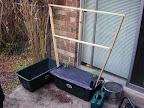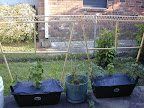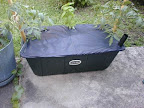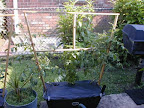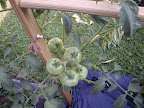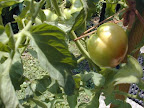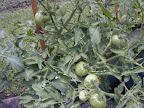I bought a trimmed brisket flat for $1.19/lb. At about 4.75 pounds, it woudn’t be an extended cook. A “flat” is one of two parts that comprise a “whole” brisket. The other part, known as a “point” is not usually offered for sale separately. The point is typically fattier than the flat. The two parts are essentially two different muscles from the breast area of the cow connected in a sort of offset manner by a vein of fat. Brisket flats are usually offered trimmed of most if not all of the layer of fat known as the “fat cap”.
I prepped the flat the night before, by sprinkling both sides liberally with McCormick’s Montreal Steak Seasoning. Sounds unconventional, but it proved very tasty.
Firing up the Bullet conventionally, I used 2 Weber chimneyfulls of Kingsford. I took the opportunity to try out my new Polder remote digital thermometer.
Temperatures on the Bullet stabilized quickly, and I added the meat and inserted the thermometer probe. I also threw on a slab of pork spares– next to the brisket on the top grate– and two butterflied four pound chickens on the middle grate . Over the next several hours, the temperatures hung rock-solid at 240�.
The meat temp rose slowly, but, suddenly, the remote thermometer reading jumped up 30� in a matter of seconds. I tested with an instant read, and found the remote to be in error. I turned off the remote, and then turned it back on, hoping it was just momentarily confused. It seemed to return to normal. Later, it did it again, so I just removed it, and decided to spot check with the instant read from time to time, when I turned and basted. Later I tried the remote again, this time to read cooker temperature, and it misbehaved similarly.
At some point, around 3-1/2 hours, I checked the chickens, which were done, and removed them to a warm oven to await dinner. At the 5-1/2 hour mark, I removed the ribs, sauced and foiled them, and placed them the oven along with the chickens. I later pulled the brisket flat when it reached 180� internal, and let it rest before slicing.
The ribs were very tender and tasty, but the brisket was the star– fork tender, juicy,and flavorful. I’ll try a whole one next time.
